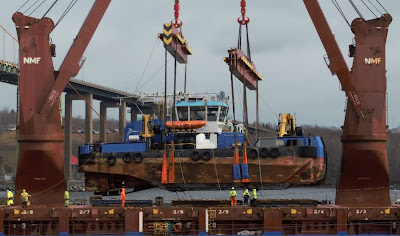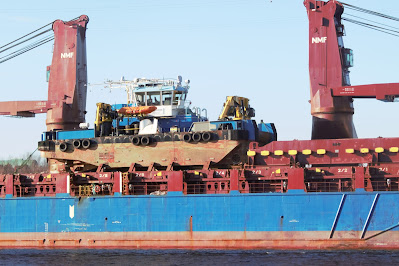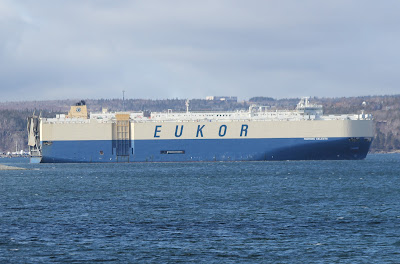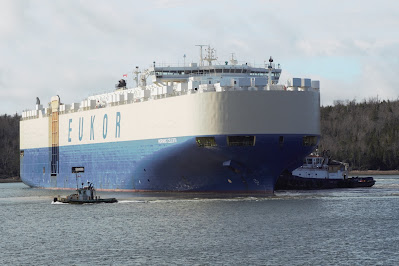After the horrific bridge collapse in Baltimore March 24, 2024 the question must be asked, could it happen here in Halifax? An investigation will eventually determine exactly what caused the container ship Dali to lose power and strike the Frances Scott Key bridge. What is known, and recorded so vividly on video, is that the impact caused a catastrophic collapse of several spans of the bridge, throwing vehicles and people into the water, with many dead and missing.
Aside from the tragic loss of life, the economic impact of such a disaster is almost inconcievable.
Power failures, fires and blackouts on ships are more common that one may think, and when they occur the ship loses the ability to slow (by reversing propellor or pitch) and to steer. Losing electrical power also shuts down lighting, navigation aids such as radar and radio communication on the ship itself and with shore.
When disasters like the Key bridge occur agencies the world over review their safety policies and there will no doubt be changes in many places. However as it stands in Halifax there are several safety measures already in place and protocols for ships passing under our two harbour bridges.
1. Bridge Structure
Bridges are built to support themselves but not to withstand impacts like ship strikes. In March 1982 the jack-up oil rig the Zapata Scotian, designed to drill in 200 feet of water, was mounted on a large barge in Halifax. High winds caused the barge's mooring lines to part and the barge, with rig on deck, began to drift up the harbour. Navy tugs scrambled, and secured the rig only 30 meters from the Dartmouth ferry terminal, where it would have run aground. An official spokeperson stated that the rig was "never a danger" to the Angus L. Macdonald bridge, which was clearly untrue. Anyone with two eyes could see that its jack-up legs would never fit under the Macdonald bridge.
Compare the size of the tug to the rig, on its barge at Pier 23. (Trivia: Zapata Petroleum Corporation was founded by future U.S. President George H.W. Bush)
Following this incident rock islands were built around the abutments of both bridges. These structures were to stop ships before they reach the bridge structure.
A rock island surrounds the Dartmouth abutment (above at right) of the A. Murray MacKay bridge. The Halifax abutment (left in photo) is on shore and has gravel around the base extending out into the harbour (photo below) but is far out of the shipping channel and in shallow water in any event.
2. Air Draft*
There is concern that ships may be too "tall" to fit beneath the bridges. Ships must therefore submit their "air draft" before receiving permission to pass the bridges. Communication is through the Coast Guard's Vessel Traffic Management System (MCTS) and the Halifax Port Authority. Sensors on the bridge monitor the clearance height, which varies with the state of the tide. (The ship's air draft varies with the amount of "keel draft", and some ships must strike (meaning lower) their signal mast(s) to reduce air draft.)
The clearance calculation is made for each ship passage and the amount of clearance is then transmitted back to the ship by VHF radio and permission (if granted) is given to pass under the bridges. There are visual markers on the bridge so that the harbour pilot can see the exact centre (and highest point) of the span, and the two sides of the channel, as there is a slight arch to the bridge deck of both bridges. There is to be a minumum clearance of 1.36 meters between ship and bridge.
A yellow placard marks high point at the centre of the Angus L. Macdonald bridge.
*The above is a very much simplified version of the harbour regulations. A detailed description of the required procedures can be found in the Port of Halifax "Port Information Guide"posted on the Port's web site at: https://www.portofhalifax.ca/wp-content/uploads/2024/01/HPA-PortInformationGuide-January2024-1.pdf
3. Use of Tugs
Large ships are most effective out at sea. Once in port they tend to be ungainly. They do not steer well at slow speed and are subject to wind pressure (particularly high sided ships like container ships and auto carriers) and they can perform unpredictably in shallow and narrow waters. They also take a long time to stop. They do not have "brakes", but must reverse their propellors (or the pitch of the propellor), which work most effectively in the forward direction and poorly in the reverse direction.
Tugs are employed to assist ships in port, both in coming alongside at terminals, but also in maintaining course in the outer "approach" channels and in transiting the Narrows. They can redirect ships, or slow and stop them by pulling on a stern line.
Port regulations are quite strict on the use of tugs in the port, particularly in the Narrows where the two harbour bridges are located, so I will not decribe the requirements in detail except to say that ships require one or more tugs, depending on the size of the ship, with specific requirements for container ships. The harbour pilots have ultimate discretion in the number of tugs and may exceed the minimum number required based on conditions.
Again there is more detail in the "Port Information Guide"; https://www.portofhalifax.ca/wp-content/uploads/2024/01/HPA-PortInformationGuide-January2024-1.pdf
The container ship NYK Remus with tugs, passes the A. Murray MacKay bridge heading for Bedford Basin, in dead calm conditions and at nearly high tide.
4. Conditions and Situations
The Port of Halifax has had its own experience with catastrophe. The collision of two ships in the Narrows on December 6, 1917 and subsequent fire and explosion levelled the northern portion of the city and caused the deaths of at least 1,800 people, with 9,000 injured, many more homeless and unmeasurable property damage. Haligonians are very aware of this event event more than a century later, and many will be feeling deep sympathy for our neighbours to the south.
The Port of Halifax regulations now set out how ships are to meet (large ships are not permitted to meet in the Narrows) and with better communications the harbour is a much safer place than it was.
Traffic in the Narrows for high sided ships may be restricted in high wind conditions, and deep draft ships may also be restricted depending on the state of the tide.
And yet.....
Ships continue to experience blackouts, power loss and steering failure, with disturbing regularity. Some container lines (even well known ones) continue to operate ships past their "best before date" [usually 25 years] or fail to provide adequate maintenance. Older ships, like older cars, can be unpredictable and equipment failures due simply to wear, tear and fatigue will occur perhaps without warning.
A ship that caught fire on the St.Lawrence River recently threatened to run aground as it lost control of its engine and steering. That ship, the MSC Sao Paulo V is due in Halifax later this week (in tow - its engine is not operational) and will have to be towed to Europe - with all its cargo. [see also companion blog Tugfax] The cost to the ship owner and the cargo owners and insurers will be high, but would it have been predictable that a 26 year old ship might be a liability?
A systems blackout occured in Halifax last year when a ship lost power as it approached the Angus L. Macdonald bridge as it arrived from sea. The pilot on board followed the protocol and transmitted a "Pan Pan" (emergency) radio message which instructed the bridge to stop traffic. From what I hear someone on the bridge decided that it was not an emergancy and elected not to follow the protocol. That is unfortunate, but after today's Baltimore disaster, one hopes, is unlikely to recur.
5. Halifax and Baltimore
Some ships that call in Halifax also call in Baltimore. This includes auto carriers and container ships (notably ACL). Baltimore is also the destination for gypsum mined in Nova Scotia and exported through Halifax by Gold Bond Gypsum. All these will find work arounds but there is not expected to be any specific effect on the business of the Port of Halifax.
It seems unlikely that Halifax can be of assistance to the Port of Baltimore because there are several nearer ports that can handle diverted traffic. However it seems likely that it will be a very long time before the Port of Baltimore will be able to return to anything like normal operation and there will be changes in trade routes, maybe permanent ones, in Baltimore and elsewhere.
6. The Answer
The Port of Halifax will certainly be reviewing its procedures in consultation with users and other regulators and authorities, here and world wide, and changes may be on the way. I expect that there will be more restrictions on traffic through the Narrows, and non-container ships, like gypsum carriers, may require tug escorts while inbound and outbound. (The Algoma Vision sailed this morning for Tampa and did not use an escort tug.)
So the simple answer to the question "Could it happen here?" is a conditional yes. There are many safeguards in place, likely to be strengthened now, so the likelihood of it happening here is slight and probably even less so as time goes on due to a heightened awareness of the dangers.
As the world expresses sympathy to those experiencing what was once an inconceivable loss, perhaps more safeguards will be instituted here in Halifax and elswhere to try to reduce the risk of a recurrence even more.
.


















%20amm%20ROCK%20ISLAND.JPG)

































